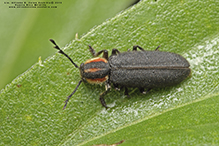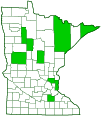Pilose checkered beetle
(Chariessa pilosa)
Conservation • Description • Habitat • Ecology • Distribution • Taxonomy
Conservation Status |
|||
| IUCN Red List | not listed |
||
| NatureServe | NNR - Unranked |
||
| Minnesota | not listed |
||
Description |
Pilose checkered beetle is a small to medium-sized predaceous beetle. It occurs in North America east of the Great Plains. It may be the most widely distributed checkered beetle (family Cleridae) in North America. It is one of the most common checkered beetles in the eastern United States, but is uncommon in Minnesota, where it is at the western extent of its range. It is found from May to July in deciduous forests and woodlands. The larvae prey on a variety of wood-boring beetles. The feed on the eggs, larvae, and adults found in beetle galleries in the bark of hardwoods. They are considered beneficial because they may prevent or mitigate an outbreak of wood-boring beetles. Adults feed on many adult insects. Pilose checkered beetle looks like a hairy firefly. It is mostly dark brown and is covered with bristly hairs. The body is elongate, narrow, somewhat cylindrical, ¼″ to ⅝″ (7 to 15 mm) long, and 1⁄16″ to ¼″ (2.5 to 5.7 mm) wide. The head and mouthparts are directed downward. The head is as wide as the exoskeletal plate covering the thorax (pronotum). The compound eyes are bulging and finely granular. The antennae have 11 segments. The last 3 segments are expanded and form a loose club. The club is noticeably larger on males than on females. On the male, the lobe on the ninth and tenth segments is an elongated, finger-like branch. On the female they are shorter and sharply triangular. The pronotum is slightly wider than long and is narrower than the base of the wing covers (elytra). It is densely covered with fine pits (punctures). The margins are reddish-yellow, the interior reddish. There are two thick, black, somewhat parallel stripes in the middle, separated by a thin reddish line. There is no tuft of hairs between the lines. The elytra are dark brown and soft. The outer (lateral) and inner (sutural) margins are pale. The legs are dark brown. The last part of the leg (tarsus), corresponding to the foot, has 5 segments. At the end of each tarsus there is a pair of claws and a hairy pad between the claws. The claws are of equal size. Each claw has a single tooth. |
Size |
Total length: ¼″ to ⅝″ (7 to 15 mm) |
Similar Species |
Habitat |
Deciduous forests and woodlands |
Ecology |
Season |
May to July |
Behavior |
Adults are active during the day but will come to lights at night. |
Life Cycle |
|
Larva Food |
|
Adult Food |
|
Distribution |
||
|
Sources Opitz, Weston, "Classification, natural history, and evolution of the subfamily Peloniinae Opitz (Coleoptera: Cleroidea: Cleridae). Part VIII. Systematics of the checkered beetle genus Chariessa Perty" (2017). Insecta Mundi. 1063. |
|
| 9/25/2025 | ||
Occurrence |
||
|
||
Taxonomy |
|
Order |
Coleoptera (Beetles) |
Suborder |
Polyphaga (Water, Rove, Scarab, Long-horned, Leaf, and Snout Beetles) |
Infraorder |
Cucujiformia |
Superfamily |
Cleroidea (bark-gnawing, checkered, and soft-winged flower beetles) |
Family |
Cleridae (checkered beetles) |
Subfamily |
Peloniinae |
Genus |
Chariessa |
Subordinate Taxa |
|
|
|
Synonyms |
|
|
|
Common Names |
|
pilose checkered beetle |
|
Glossary
Elytra
The hardened or leathery forewings of beetles used to protect the fragile hindwings, which are used for flying. Singular: elytron.
Pronotum
The exoskeletal plate on the upper side of the first segment of the thorax of an insect.
Tarsus
On insects, the last two to five subdivisions of the leg, attached to the tibia; the foot. On spiders, the last segment of the leg. Plural: tarsi.
Visitor Photos
Share your photo of this insect.
This button not working for you?
Simply email us at info@MinnesotaSeasons.com.
Attach one or more photos and, if you like, a caption.
Alfredo Colon |
 |
MinnesotaSeasons.com Photos
|

Slideshows

Visitor Videos
Share your video of this insect.
This button not working for you?
Simply email us at info@MinnesotaSeasons.com.
Attach a video, a YouTube link, or a cloud storage link.
Other Videos



